Question Number 113682 by mohammad17 last updated on 14/Sep/20
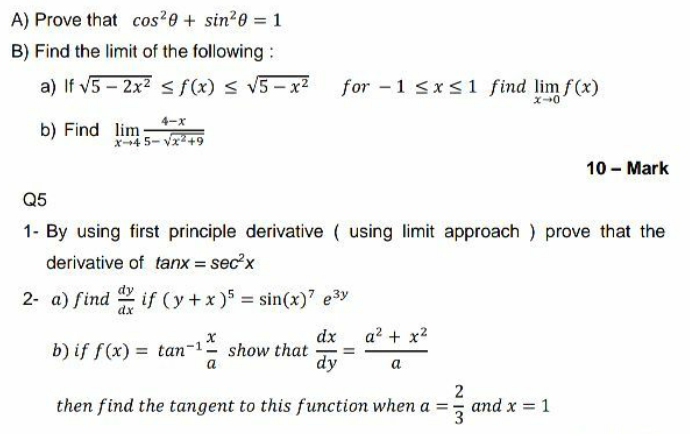
Commented by mohammad17 last updated on 14/Sep/20

$${thank}\:{you}\:{sir} \\ $$
Answered by Dwaipayan Shikari last updated on 14/Sep/20

$$\underset{{x}\rightarrow\mathrm{4}} {\mathrm{lim}}\frac{\mathrm{4}−{x}}{\mathrm{5}−\sqrt{{x}^{\mathrm{2}} +\mathrm{9}}} \\ $$$$\underset{{x}\rightarrow\mathrm{4}} {\mathrm{lim}}\frac{\mathrm{4}−{x}}{\mathrm{25}−{x}^{\mathrm{2}} −\mathrm{9}}.\left(\mathrm{5}+\sqrt{{x}^{\mathrm{2}} +\mathrm{9}}\right)=\frac{\mathrm{4}−{x}}{\left(\mathrm{4}−{x}\right)\left(\mathrm{4}+{x}\right)}.\left(\mathrm{5}+\mathrm{5}\right)=\frac{\mathrm{5}}{\mathrm{4}} \\ $$
Commented by mohammad17 last updated on 15/Sep/20

$${thank}\:{you}\:{sir} \\ $$
Answered by Dwaipayan Shikari last updated on 14/Sep/20
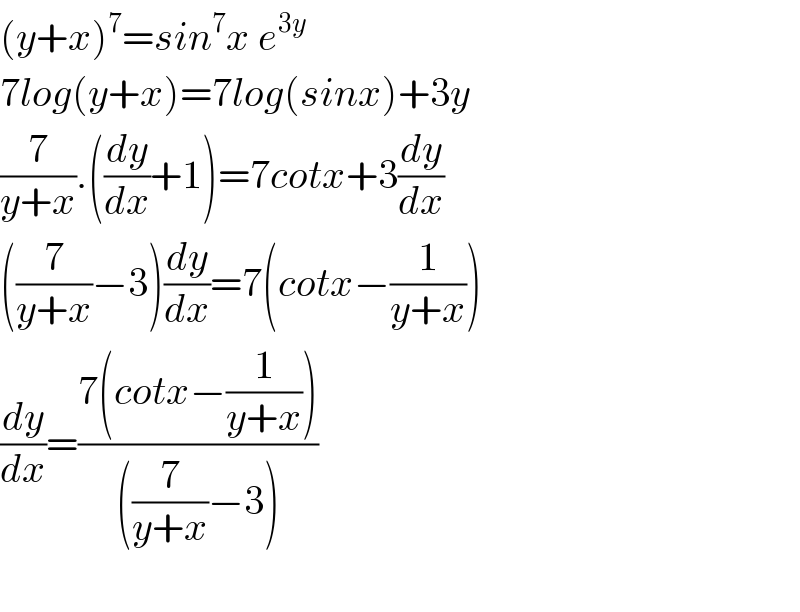
$$\left({y}+{x}\right)^{\mathrm{7}} ={sin}^{\mathrm{7}} {x}\:{e}^{\mathrm{3}{y}} \\ $$$$\mathrm{7}{log}\left({y}+{x}\right)=\mathrm{7}{log}\left({sinx}\right)+\mathrm{3}{y} \\ $$$$\frac{\mathrm{7}}{{y}+{x}}.\left(\frac{{dy}}{{dx}}+\mathrm{1}\right)=\mathrm{7}{cotx}+\mathrm{3}\frac{{dy}}{{dx}} \\ $$$$\left(\frac{\mathrm{7}}{{y}+{x}}−\mathrm{3}\right)\frac{{dy}}{{dx}}=\mathrm{7}\left({cotx}−\frac{\mathrm{1}}{{y}+{x}}\right) \\ $$$$\frac{{dy}}{{dx}}=\frac{\mathrm{7}\left({cotx}−\frac{\mathrm{1}}{{y}+{x}}\right)}{\left(\frac{\mathrm{7}}{{y}+{x}}−\mathrm{3}\right)} \\ $$$$ \\ $$
Commented by mohammad17 last updated on 15/Sep/20

$${thank}\:{you}\:{sir} \\ $$
Answered by Mr.D.N. last updated on 14/Sep/20
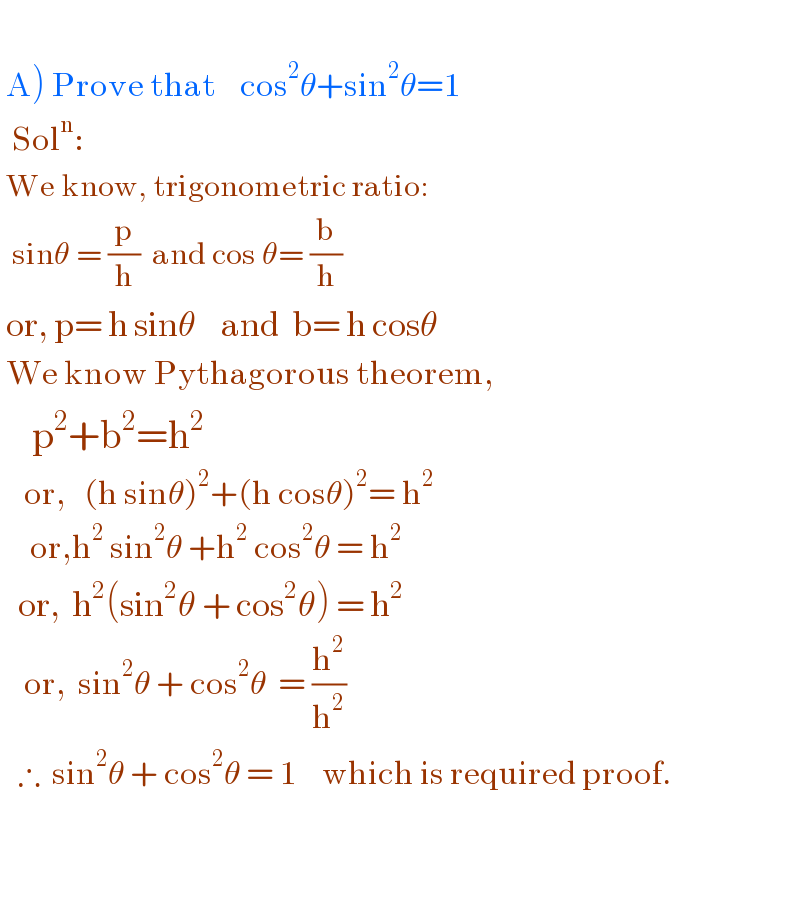
$$\: \\ $$$$\left.\:\mathrm{A}\right)\:\mathrm{Prove}\:\mathrm{that}\:\:\:\:\mathrm{cos}^{\mathrm{2}} \theta+\mathrm{sin}^{\mathrm{2}} \theta=\mathrm{1} \\ $$$$\:\:\mathrm{Sol}^{\mathrm{n}} :\:\: \\ $$$$\:\mathrm{We}\:\mathrm{know},\:\mathrm{trigonometric}\:\mathrm{ratio}: \\ $$$$\:\:\mathrm{sin}\theta\:=\:\frac{\mathrm{p}}{\mathrm{h}}\:\:\mathrm{and}\:\mathrm{cos}\:\theta=\:\frac{\mathrm{b}}{\mathrm{h}}\: \\ $$$$\:\mathrm{or},\:\mathrm{p}=\:\mathrm{h}\:\mathrm{sin}\theta\:\:\:\:\mathrm{and}\:\:\mathrm{b}=\:\mathrm{h}\:\mathrm{cos}\theta \\ $$$$\:\mathrm{We}\:\mathrm{know}\:\mathrm{Pythagorous}\:\mathrm{theorem}, \\ $$$$\:\:\:\:\mathrm{p}^{\mathrm{2}} +\mathrm{b}^{\mathrm{2}} =\mathrm{h}^{\mathrm{2}} \\ $$$$\:\:\:\:\mathrm{or},\:\:\:\left(\mathrm{h}\:\mathrm{sin}\theta\right)^{\mathrm{2}} +\left(\mathrm{h}\:\mathrm{cos}\theta\right)^{\mathrm{2}} =\:\mathrm{h}^{\mathrm{2}} \\ $$$$\:\:\:\:\:\mathrm{or},\mathrm{h}^{\mathrm{2}} \:\mathrm{sin}^{\mathrm{2}} \theta\:+\mathrm{h}^{\mathrm{2}} \:\mathrm{cos}^{\mathrm{2}} \theta\:=\:\mathrm{h}^{\mathrm{2}} \\ $$$$\:\:\:\mathrm{or},\:\:\mathrm{h}^{\mathrm{2}} \left(\mathrm{sin}^{\mathrm{2}} \theta\:+\:\mathrm{cos}^{\mathrm{2}} \theta\right)\:=\:\mathrm{h}^{\mathrm{2}} \\ $$$$\:\:\:\:\mathrm{or},\:\:\mathrm{sin}^{\mathrm{2}} \theta\:+\:\mathrm{cos}^{\mathrm{2}} \theta\:\:=\:\frac{\mathrm{h}^{\mathrm{2}} }{\mathrm{h}^{\mathrm{2}} } \\ $$$$\:\:\:\therefore\:\:\mathrm{sin}^{\mathrm{2}} \theta\:+\:\mathrm{cos}^{\mathrm{2}} \theta\:=\:\mathrm{1}\:\:\:\:\mathrm{which}\:\mathrm{is}\:\mathrm{required}\:\mathrm{proof}. \\ $$$$\: \\ $$$$ \\ $$
Commented by mohammad17 last updated on 15/Sep/20

$${thank}\:{you}\:{sir} \\ $$
Answered by Mr.D.N. last updated on 14/Sep/20
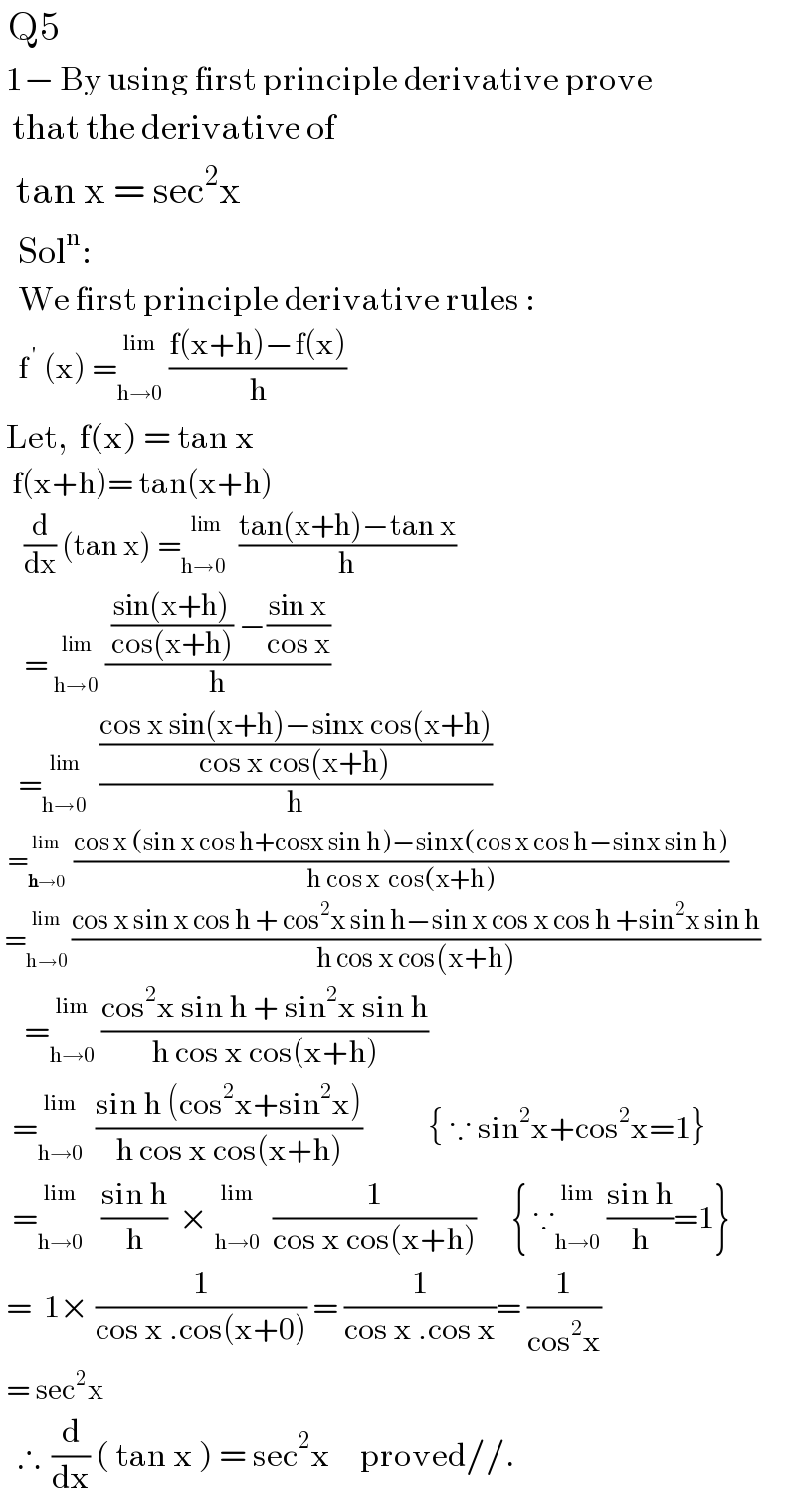
$$\:\mathrm{Q5} \\ $$$$\:\mathrm{1}−\:\mathrm{By}\:\mathrm{using}\:\mathrm{first}\:\mathrm{principle}\:\mathrm{derivative}\:\mathrm{prove} \\ $$$$\:\:\mathrm{that}\:\mathrm{the}\:\mathrm{derivative}\:\mathrm{of} \\ $$$$\:\:\mathrm{tan}\:\mathrm{x}\:=\:\mathrm{sec}^{\mathrm{2}} \mathrm{x} \\ $$$$\:\:\:\mathrm{Sol}^{\mathrm{n}} :\:\:\: \\ $$$$\:\:\:\mathrm{We}\:\mathrm{first}\:\mathrm{principle}\:\mathrm{derivative}\:\mathrm{rules}\:: \\ $$$$\:\:\:\mathrm{f}^{\:'} \:\left(\mathrm{x}\right)\:=\underset{\mathrm{h}\rightarrow\mathrm{0}} {\overset{\mathrm{lim}} {\:}}\:\frac{\mathrm{f}\left(\mathrm{x}+\mathrm{h}\right)−\mathrm{f}\left(\mathrm{x}\right)}{\mathrm{h}} \\ $$$$\:\mathrm{Let},\:\:\mathrm{f}\left(\mathrm{x}\right)\:=\:\mathrm{tan}\:\mathrm{x} \\ $$$$\:\:\mathrm{f}\left(\mathrm{x}+\mathrm{h}\right)=\:\mathrm{tan}\left(\mathrm{x}+\mathrm{h}\right) \\ $$$$\:\:\:\:\frac{\mathrm{d}}{\mathrm{dx}}\:\left(\mathrm{tan}\:\mathrm{x}\right)\:=\underset{\mathrm{h}\rightarrow\mathrm{0}} {\overset{\:\mathrm{lim}} {\:}}\:\:\frac{\mathrm{tan}\left(\mathrm{x}+\mathrm{h}\right)−\mathrm{tan}\:\mathrm{x}}{\mathrm{h}} \\ $$$$\:\:\:\:=\:\underset{\mathrm{h}\rightarrow\mathrm{0}} {\overset{\mathrm{lim}} {\:}}\:\frac{\:\frac{\mathrm{sin}\left(\mathrm{x}+\mathrm{h}\right)}{\mathrm{cos}\left(\mathrm{x}+\mathrm{h}\right)}\:−\frac{\mathrm{sin}\:\mathrm{x}}{\mathrm{cos}\:\mathrm{x}}}{\mathrm{h}} \\ $$$$\:\:\:=\underset{\mathrm{h}\rightarrow\mathrm{0}} {\overset{\mathrm{lim}} {\:}}\:\:\frac{\frac{\mathrm{cos}\:\mathrm{x}\:\mathrm{sin}\left(\mathrm{x}+\mathrm{h}\right)−\mathrm{sinx}\:\mathrm{cos}\left(\mathrm{x}+\mathrm{h}\right)}{\mathrm{cos}\:\mathrm{x}\:\mathrm{cos}\left(\mathrm{x}+\mathrm{h}\right)}}{\mathrm{h}} \\ $$$$\:\:=\underset{\boldsymbol{\mathrm{h}}\rightarrow\mathrm{0}} {\overset{\mathrm{lim}} {\:}}\:\:\frac{\mathrm{cos}\:\mathrm{x}\:\left(\mathrm{sin}\:\mathrm{x}\:\mathrm{cos}\:\mathrm{h}+\mathrm{cosx}\:\mathrm{sin}\:\mathrm{h}\right)−\mathrm{sinx}\left(\mathrm{cos}\:\mathrm{x}\:\mathrm{cos}\:\mathrm{h}−\mathrm{sinx}\:\mathrm{sin}\:\mathrm{h}\right)}{\mathrm{h}\:\mathrm{cos}\:\mathrm{x}\:\:\mathrm{cos}\left(\mathrm{x}+\mathrm{h}\right)} \\ $$$$\:=\underset{\mathrm{h}\rightarrow\mathrm{0}} {\overset{\mathrm{lim}} {\:}}\:\frac{\mathrm{cos}\:\mathrm{x}\:\mathrm{sin}\:\mathrm{x}\:\mathrm{cos}\:\mathrm{h}\:+\:\mathrm{cos}^{\mathrm{2}} \mathrm{x}\:\mathrm{sin}\:\mathrm{h}−\mathrm{sin}\:\mathrm{x}\:\mathrm{cos}\:\mathrm{x}\:\mathrm{cos}\:\mathrm{h}\:+\mathrm{sin}^{\mathrm{2}} \mathrm{x}\:\mathrm{sin}\:\mathrm{h}}{\mathrm{h}\:\mathrm{cos}\:\mathrm{x}\:\mathrm{cos}\left(\mathrm{x}+\mathrm{h}\right)} \\ $$$$\:\:\:\:=\underset{\mathrm{h}\rightarrow\mathrm{0}} {\overset{\mathrm{lim}} {\:}}\:\frac{\mathrm{cos}^{\mathrm{2}} \mathrm{x}\:\mathrm{sin}\:\mathrm{h}\:+\:\mathrm{sin}^{\mathrm{2}} \mathrm{x}\:\mathrm{sin}\:\mathrm{h}}{\mathrm{h}\:\mathrm{cos}\:\mathrm{x}\:\mathrm{cos}\left(\mathrm{x}+\mathrm{h}\right)} \\ $$$$\:\:=\underset{\mathrm{h}\rightarrow\mathrm{0}} {\overset{\mathrm{lim}} {\:}}\:\:\frac{\mathrm{sin}\:\mathrm{h}\:\left(\mathrm{cos}^{\mathrm{2}} \mathrm{x}+\mathrm{sin}^{\mathrm{2}} \mathrm{x}\right)}{\mathrm{h}\:\mathrm{cos}\:\mathrm{x}\:\mathrm{cos}\left(\mathrm{x}+\mathrm{h}\right)}\:\:\:\:\:\:\:\:\:\:\:\left\{\:\because\:\mathrm{sin}^{\mathrm{2}} \mathrm{x}+\mathrm{cos}^{\mathrm{2}} \mathrm{x}=\mathrm{1}\right\} \\ $$$$\:\:=\underset{\mathrm{h}\rightarrow\mathrm{0}} {\overset{\mathrm{lim}} {\:}}\:\:\:\frac{\mathrm{sin}\:\mathrm{h}}{\mathrm{h}}\:\:×\:\underset{\mathrm{h}\rightarrow\mathrm{0}} {\overset{\mathrm{lim}} {\:}}\:\:\frac{\mathrm{1}}{\mathrm{cos}\:\mathrm{x}\:\mathrm{cos}\left(\mathrm{x}+\mathrm{h}\right)}\:\:\:\:\:\:\left\{\:\because\underset{\mathrm{h}\rightarrow\mathrm{0}} {\overset{\mathrm{lim}} {\:}}\:\frac{\mathrm{sin}\:\mathrm{h}}{\mathrm{h}}=\mathrm{1}\right\} \\ $$$$\:=\:\:\mathrm{1}×\:\frac{\mathrm{1}}{\mathrm{cos}\:\mathrm{x}\:.\mathrm{cos}\left(\mathrm{x}+\mathrm{0}\right)}\:=\:\frac{\mathrm{1}}{\mathrm{cos}\:\mathrm{x}\:.\mathrm{cos}\:\mathrm{x}}=\:\frac{\mathrm{1}}{\mathrm{cos}^{\mathrm{2}} \mathrm{x}} \\ $$$$\:=\:\mathrm{sec}^{\mathrm{2}} \mathrm{x} \\ $$$$\:\:\:\therefore\:\:\frac{\mathrm{d}}{\mathrm{dx}}\:\left(\:\mathrm{tan}\:\mathrm{x}\:\right)\:=\:\mathrm{sec}^{\mathrm{2}} \mathrm{x}\:\:\:\:\:\mathrm{proved}//. \\ $$
Commented by mohammad17 last updated on 15/Sep/20

$${thank}\:{you}\:{sir} \\ $$
Answered by Mr.D.N. last updated on 14/Sep/20
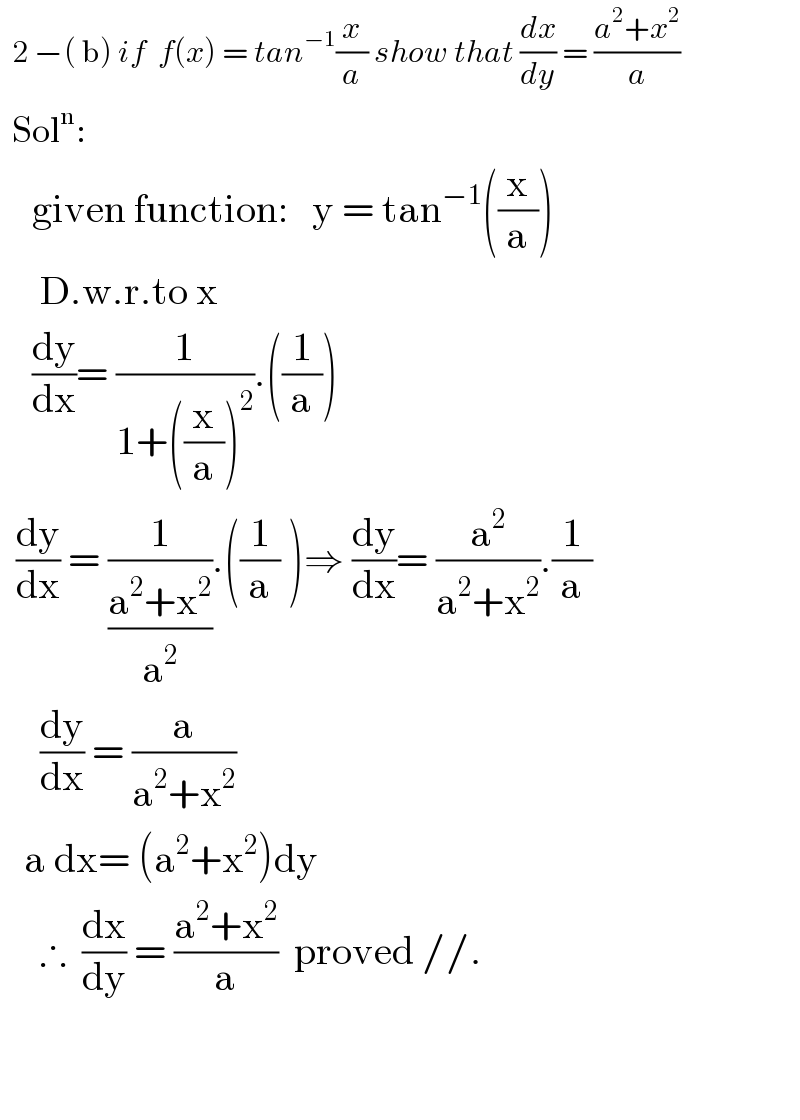
$$\:\:\mathrm{2}\:−\left(\:\mathrm{b}\right)\:{if}\:\:{f}\left({x}\right)\:=\:{tan}^{−\mathrm{1}} \frac{{x}}{{a}}\:{show}\:{that}\:\frac{{dx}}{{dy}}\:=\:\frac{{a}^{\mathrm{2}} +{x}^{\mathrm{2}} }{{a}}\:\:\: \\ $$$$\:\:\mathrm{Sol}^{\mathrm{n}} : \\ $$$$\:\:\:\:\mathrm{given}\:\mathrm{function}:\:\:\:\mathrm{y}\:=\:\mathrm{tan}^{−\mathrm{1}} \left(\frac{\mathrm{x}}{\mathrm{a}}\right) \\ $$$$\:\:\:\:\:\mathrm{D}.\mathrm{w}.\mathrm{r}.\mathrm{to}\:\mathrm{x} \\ $$$$\:\:\:\:\frac{\mathrm{dy}}{\mathrm{dx}}=\:\frac{\mathrm{1}}{\mathrm{1}+\left(\frac{\mathrm{x}}{\mathrm{a}}\right)^{\mathrm{2}} }.\left(\frac{\mathrm{1}}{\mathrm{a}}\right) \\ $$$$\:\:\frac{\mathrm{dy}}{\mathrm{dx}}\:=\:\frac{\mathrm{1}}{\frac{\mathrm{a}^{\mathrm{2}} +\mathrm{x}^{\mathrm{2}} }{\mathrm{a}^{\mathrm{2}} }}.\left(\frac{\mathrm{1}}{\mathrm{a}}\:\right)\Rightarrow\:\frac{\mathrm{dy}}{\mathrm{dx}}=\:\frac{\mathrm{a}^{\mathrm{2}} }{\mathrm{a}^{\mathrm{2}} +\mathrm{x}^{\mathrm{2}} }.\frac{\mathrm{1}}{\mathrm{a}} \\ $$$$\:\:\:\:\:\frac{\mathrm{dy}}{\mathrm{dx}}\:=\:\frac{\mathrm{a}}{\mathrm{a}^{\mathrm{2}} +\mathrm{x}^{\mathrm{2}} } \\ $$$$\:\:\:\mathrm{a}\:\mathrm{dx}=\:\left(\mathrm{a}^{\mathrm{2}} +\mathrm{x}^{\mathrm{2}} \right)\mathrm{dy} \\ $$$$\:\:\:\:\:\therefore\:\:\frac{\mathrm{dx}}{\mathrm{dy}}\:=\:\frac{\mathrm{a}^{\mathrm{2}} +\mathrm{x}^{\mathrm{2}} }{\mathrm{a}}\:\:\mathrm{proved}\://. \\ $$$$ \\ $$$$ \\ $$
Commented by mohammad17 last updated on 15/Sep/20

$${thank}\:{you}\:{sir} \\ $$
Answered by mathmax by abdo last updated on 14/Sep/20
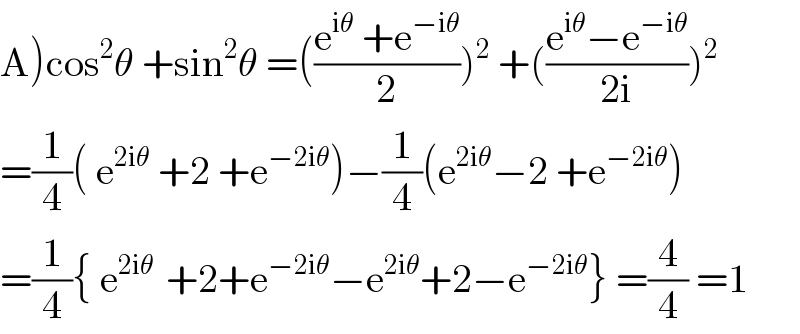
$$\left.\mathrm{A}\right)\mathrm{cos}^{\mathrm{2}} \theta\:+\mathrm{sin}^{\mathrm{2}} \theta\:=\left(\frac{\mathrm{e}^{\mathrm{i}\theta} \:+\mathrm{e}^{−\mathrm{i}\theta} }{\mathrm{2}}\right)^{\mathrm{2}} \:+\left(\frac{\mathrm{e}^{\mathrm{i}\theta} −\mathrm{e}^{−\mathrm{i}\theta} }{\mathrm{2i}}\right)^{\mathrm{2}} \\ $$$$=\frac{\mathrm{1}}{\mathrm{4}}\left(\:\mathrm{e}^{\mathrm{2i}\theta} \:+\mathrm{2}\:+\mathrm{e}^{−\mathrm{2i}\theta} \right)−\frac{\mathrm{1}}{\mathrm{4}}\left(\mathrm{e}^{\mathrm{2i}\theta} −\mathrm{2}\:+\mathrm{e}^{−\mathrm{2i}\theta} \right) \\ $$$$=\frac{\mathrm{1}}{\mathrm{4}}\left\{\:\mathrm{e}^{\mathrm{2i}\theta\:} \:+\mathrm{2}+\mathrm{e}^{−\mathrm{2i}\theta} −\mathrm{e}^{\mathrm{2i}\theta} +\mathrm{2}−\mathrm{e}^{−\mathrm{2i}\theta} \right\}\:=\frac{\mathrm{4}}{\mathrm{4}}\:=\mathrm{1} \\ $$
Commented by mohammad17 last updated on 15/Sep/20

$${thank}\:{you}\:{sir} \\ $$
Commented by mathmax by abdo last updated on 16/Sep/20

$$\mathrm{you}\:\mathrm{are}\:\mathrm{welcome} \\ $$
Answered by mathmax by abdo last updated on 15/Sep/20
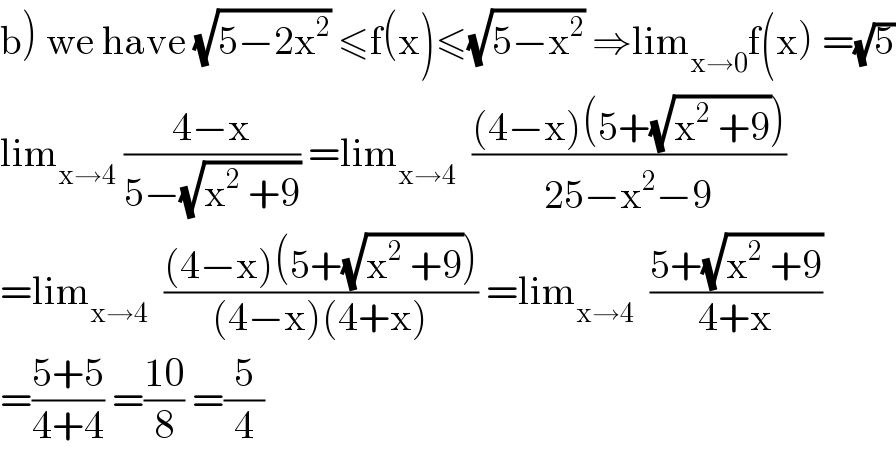
$$\left.\mathrm{b}\right)\:\mathrm{we}\:\mathrm{have}\:\sqrt{\mathrm{5}−\mathrm{2x}^{\mathrm{2}} }\:\leqslant\mathrm{f}\left(\mathrm{x}\right)\leqslant\sqrt{\mathrm{5}−\mathrm{x}^{\mathrm{2}} }\:\Rightarrow\mathrm{lim}_{\mathrm{x}\rightarrow\mathrm{0}} \mathrm{f}\left(\mathrm{x}\right)\:=\sqrt{\mathrm{5}} \\ $$$$\mathrm{lim}_{\mathrm{x}\rightarrow\mathrm{4}} \:\frac{\mathrm{4}−\mathrm{x}}{\mathrm{5}−\sqrt{\mathrm{x}^{\mathrm{2}} \:+\mathrm{9}}}\:=\mathrm{lim}_{\mathrm{x}\rightarrow\mathrm{4}} \:\:\frac{\left(\mathrm{4}−\mathrm{x}\right)\left(\mathrm{5}+\sqrt{\mathrm{x}^{\mathrm{2}} \:+\mathrm{9}}\right)}{\mathrm{25}−\mathrm{x}^{\mathrm{2}} −\mathrm{9}} \\ $$$$=\mathrm{lim}_{\mathrm{x}\rightarrow\mathrm{4}} \:\:\frac{\left(\mathrm{4}−\mathrm{x}\right)\left(\mathrm{5}+\sqrt{\mathrm{x}^{\mathrm{2}} \:+\mathrm{9}}\right)}{\left(\mathrm{4}−\mathrm{x}\right)\left(\mathrm{4}+\mathrm{x}\right)}\:=\mathrm{lim}_{\mathrm{x}\rightarrow\mathrm{4}} \:\:\frac{\mathrm{5}+\sqrt{\mathrm{x}^{\mathrm{2}} \:+\mathrm{9}}}{\mathrm{4}+\mathrm{x}} \\ $$$$=\frac{\mathrm{5}+\mathrm{5}}{\mathrm{4}+\mathrm{4}}\:=\frac{\mathrm{10}}{\mathrm{8}}\:=\frac{\mathrm{5}}{\mathrm{4}} \\ $$
Answered by mathmax by abdo last updated on 15/Sep/20
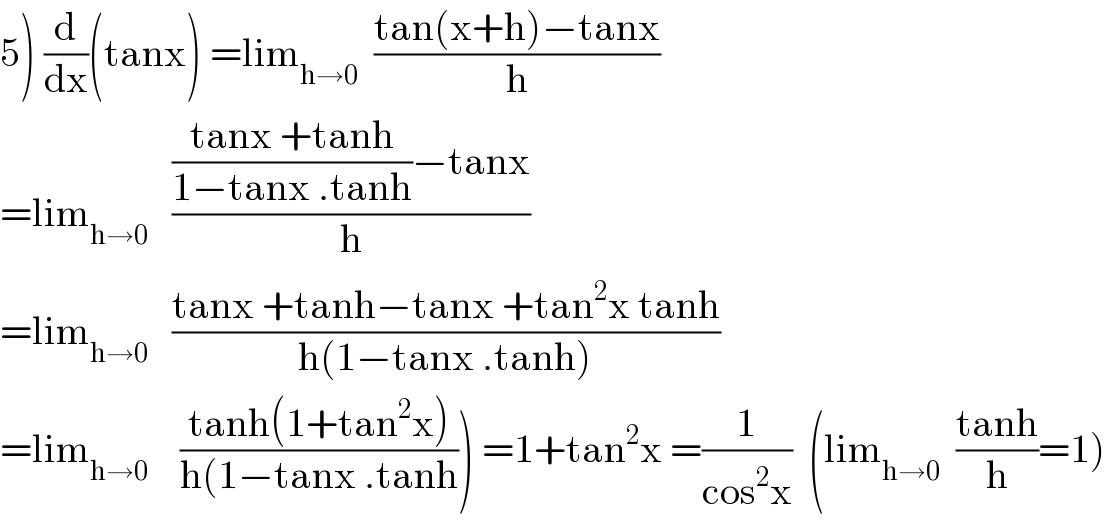
$$\left.\mathrm{5}\right)\:\frac{\mathrm{d}}{\mathrm{dx}}\left(\mathrm{tanx}\right)\:=\mathrm{lim}_{\mathrm{h}\rightarrow\mathrm{0}} \:\:\frac{\mathrm{tan}\left(\mathrm{x}+\mathrm{h}\right)−\mathrm{tanx}}{\mathrm{h}} \\ $$$$=\mathrm{lim}_{\mathrm{h}\rightarrow\mathrm{0}} \:\:\:\frac{\frac{\mathrm{tanx}\:+\mathrm{tanh}}{\mathrm{1}−\mathrm{tanx}\:.\mathrm{tanh}}−\mathrm{tanx}}{\mathrm{h}} \\ $$$$=\mathrm{lim}_{\mathrm{h}\rightarrow\mathrm{0}} \:\:\:\frac{\mathrm{tanx}\:+\mathrm{tanh}−\mathrm{tanx}\:+\mathrm{tan}^{\mathrm{2}} \mathrm{x}\:\mathrm{tanh}}{\mathrm{h}\left(\mathrm{1}−\mathrm{tanx}\:.\mathrm{tanh}\right)} \\ $$$$\left.=\mathrm{lim}_{\mathrm{h}\rightarrow\mathrm{0}} \:\:\:\:\frac{\mathrm{tanh}\left(\mathrm{1}+\mathrm{tan}^{\mathrm{2}} \mathrm{x}\right)}{\mathrm{h}\left(\mathrm{1}−\mathrm{tanx}\:.\mathrm{tanh}\right.}\right)\:=\mathrm{1}+\mathrm{tan}^{\mathrm{2}} \mathrm{x}\:=\frac{\mathrm{1}}{\mathrm{cos}^{\mathrm{2}} \mathrm{x}}\:\:\left(\mathrm{lim}_{\mathrm{h}\rightarrow\mathrm{0}} \:\:\frac{\mathrm{tanh}}{\mathrm{h}}=\mathrm{1}\right) \\ $$
